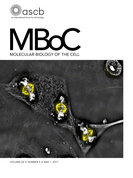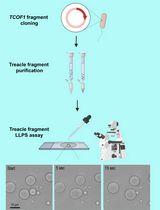- EN - English
- CN - 中文
Deoxycholate Fractionation of Fibronectin (FN) and Biotinylation Assay to Measure Recycled FN Fibrils in Epithelial Cells
在上皮细胞中利用脱氧胆酸盐分离纤维粘连蛋白以及对回收的纤维粘连蛋白原纤维的生物素化分析
发布: 2018年08月20日第8卷第16期 DOI: 10.21769/BioProtoc.2972 浏览次数: 6725
评审: Ralph Thomas BoettcherPiyali SahaAnonymous reviewer(s)
Abstract
Fibronectin (FN) is an extracellular matrix protein that is secreted by many cell types and binds predominantly to the cell surface receptor Integrin α5β1. Integrin α5β1 binding initiates the step-wise assembly of FN into fibrils, a process called fibrillogenesis. We and several others have demonstrated critical effects of fibrillogenesis on cell migration and metastasis. While immunostaining and microscopy methods help visualize FN incorporation into fibrils, with each fibril being at least 3 μm in length, the first study that developed a method to biochemically fractionate FN to quantify fibril incorporated FN was published by Jean Schwarzbauer’s group in 1996. Our protocol was adapted from the original publication, and has been tested on multiple cell types including as shown here in MCF10A mammary epithelial and Caki-1 renal cancer epithelial cells. Using two detergent extractions, cellular FN is separated into detergent insoluble or fibril incorporated FN and soluble FN or unincorporated fractions. To determine whether fibrillogenesis utilizes a recycled pool of FN, we have used a Biotin labeled FN (FN-Biotin) recycling assay, that has been modified from a previous study. Using a combination of the recycling assay and deoxycholate fractionation methods, one can quantitatively demonstrate the extent of fibrillogenesis in cells under different experimental conditions and determine the source of FN for fibrillogenesis.
Keywords: Fibronectin (FN) (纤维粘连蛋白)Background
Fibronectin (FN) is a ubiquitously produced extra cellular matrix (ECM) component (Uitto et al., 1989; Mao and Schwarzbauer, 2005). Fibronectin pools are generated transcriptionally that can be increased by several growth factors such as TGF-β1 (Yokoi et al., 2002; Mimura et al., 2004; Tang et al., 2007). The step-wise process of fibrillogenesis involving cell surface receptor Integrin α5β1 engagement with dimeric FN, drives the process of fibrillogenesis in cells (Yang and Hynes, 1996). Integrin α5β1 regulation by receptor activation/inactivation cycles, receptor endocytosis and recycling influences fibrillogenesis (Gao et al., 2000; White et al., 2007; Caswell et al., 2008) with FN contributing to net endocytosis rates of integrins in active conformations (Arjonen et al., 2012). The relevance of FN fibrillogenesis to cellular outcome has been demonstrated by numerous studies investigating fibril-specific functions for the FN protein. For example, a polymeric form of fibronectin or ‘super-fibronectin’ shows anti-metastatic and anti-angiogenic properties against different tumor types (Pasqualini et al., 1996; Yi and Ruoslahti, 2001). In the absence of a FN matrix, as observed in Von Hippel Lindau syndrome, renal cancer characterized by the mutation or loss of the Von Hippel Lindau (VHL) protein (Ohh et al., 1998; Hoffman et al., 2001), introducing a VHL mutant unable to form a fibronectin matrix is insufficient to suppress formation of tumors in SCID mice (Stickle et al., 2004). All disease mutants of the VHL gene in renal cancer also fail to form a FN matrix (Hoffman et al., 2001). Thus, analyses of fibril versus soluble FN maybe of importance to investigations that explore the contribution of the FN matrix to cellular response. Endpoint and real-time assays have been successfully used to study fibrillogenesis (Pankov et al., 2000; Mao and Schwarzbauer, 2005). Both studies rely on microscopy-based approaches to determine fibrillogenesis in cells. Biochemical fractional of FN is a quantitative approach to complement microscopy-based methods to detect levels of fibril incorporated from soluble FN. Using a fractionation assay in combination with a recycling assay, allows us to determine whether FN that is incorporated in the matrix is recycled from an existing pool of FN in the cell or from cell autonomous sources. The FN-Biotin recycling assay is simpler than classical temperature-switching assays that investigate receptor recycling (Roberts et al., 2001). Additionally, the temperature-switching assays quantify protein recycling from a decrease in rate of protein endocytosis; requiring additional lysosomal or proteasomal inhibitors in the assay. Our recycling assay can be adapted to many different proteins that localize intracellularly and at the cell membrane. While performing our FN fractionation protocol we did detect integrin β1 in the soluble and insoluble fractions. It is possible to extend this observation to perform recycling of integrins using a Biotin-conjugated integrin or any protein of interest. Alternatively, it is also possible to perform immunoprecipitation experiments on the recycled protein fraction to determine whether specific proteins interact preferentially with the two FN fractions. This protocol can help answer several questions associated with protein trafficking kinetics, interacting partner proteins and new functional characteristics based on associating proteins in the different fractions.
Materials and Reagents
- 15 ml conical tube (Thermo Fisher Scientific, catalog number: 339650 )
- Pipette tip
1,250 μl (USA Scientific, TipOne, catalog number: 1112-1720 )
200 μl (USA Scientific, TipOne, catalog number: 1110-1700 )
20 μl (USA Scientific, TipOne, catalog number: 1123-1710 )
10 μl (USA Scientific, TipOne, catalog number: 1111-3700 ) - Aluminum foil (Walmart, 551605957)
- Beaker (100 ml, WWR, catalog number: 890000-200 )
- Filter paper (GE Healthcare, catalog number: 1001-929 )
- T75 flask (Corning, catalog number: 353824 )
- Six-well tissue culture plates (Corning, catalog number: 3506 )
- Cell lifter (Fisher Scientific, FisherbrandTM, catalog number: 08-100-240 )
- 23 G needle (BD, Precision Glide, catalog number: 305193 )
- Microcentrifuge tubes (Eppendorf, catalog number: 022600028 )
- MCF10A breast cell lines (ATCC, catalog number: CRL-10317 )
- Caki-1 renal cancer cell lines (ATCC, catalog number: HTB-46 )
- Protein Ladder (Bio-Rad Laboratories, catalog number: 1610375 )
- PVDF protein transfer membrane (Merck, catalog number: IPVH08100 )
- Fibronectin antibody (Santa Cruz Biotechnology, catalog number: sc-59826 )
- Actin antibody (Abcam, catalog number: ab8227 )
- GAPDH antibody (Abcam, catalog number: ab9484 )
- Biotin labeled fibronectin (CYTOSKELETON, catalog number: FNR03 )
- Streptavidin conjugated IRDye® (LI-COR, catalog number: 926-32230 )
- IRDye 800CW Secondary Antibody (LI-COR, catalog number: 925-32210 )
- DMEM/F-12 HEPES (Thermo Fisher Scientific, GibcoTM, catalog number: 11330057 )
- Insulin (Thermo Fisher Scientific, GibcoTM, catalog number: 12585014 )
- EGF (Thermo Fisher Scientific, GibcoTM, catalog number: PHG0313 )
- Hydrocortisone (Corning, catalog number: 354203 )
- Horse Serum (Thermo Fisher Scientific, GibcoTM, catalog number: 16050122 )
- Penicillin-Streptomycin (Thermo Fisher Scientific, GibcoTM, catalog number: 15140122 )
- Cholera toxin (Sigma-Aldrich, catalog number: C8052-2MG )
- Skimmed Milk powder (Thermo Fisher Scientific, catalog number: LP0031B )
- BSA (Fisher Scientific, Fisher BioReagentsTM, catalog number: BP9703100 )
- McCoy's 5A (ATCC, catalog number: 30-2007 )
- FBS (Corning, catalog number: 35-011-CV )
- 0.05% Trypsin-EDTA (Thermo Fisher Scientific, GibcoTM, catalog number: 25300062 )
- SDS (Fisher Scientific, Fisher BioReagentsTM, catalog number: BP166-100 )
- Sodium deoxycholate (Fisher Scientific, Fisher BioReagentsTM, catalog number: BP349-100 )
- Tris Base (Fisher Scientific, Fisher BioReagentsTM, catalog number: BP152-1 )
- Tris-HCl (Fisher Scientific, Fisher BioReagentsTM, catalog number: BP153-1 )
- Glycine (Fisher Scientific, Fisher ChemicalTM, catalog number: G48-212 )
- Tween 20 (Fisher Scientific, Fisher BioReagentsTM, catalog number: BP337-500 )
- Sodium Hydroxide pellets (Fisher Scientific, Fisher ChemicalTM, catalog number: S318-1 )
- Ethanol, absolute (200 proof) (Fisher Scientific, Fisher BioReagentsTM, catalog number: BP2818500 )
- N-ethylmaleimide (Thermo Fisher Scientific, catalog number: 23030 )
- Iodoacetic acid (Thermo Fisher Scientific, catalog number: 35603 )
- DTT (Fisher Scientific, Fisher BioReagentsTM, catalog number: BP172-25 )
- Bromophenol blue (Fisher Scientific, Fisher BioReagentsTM, catalog number: BP115-25 )
- Nitrocellulose (GE Healthcare, catalog number: 10600012 )
- NaCl (Fisher Scientific, Fisher BioReagentsTM, catalog number: BP358-1 )
- KCl (Fisher Scientific, Fisher ChemicalTM, catalog number: P217-3 )
- Na2HPO4 (MP Biomedicals, catalog number: 02191440.1 )
- KH2PO4 (MP Biomedicals, catalog number: 02195453.1 )
- 100% Methanol (Fisher Scientific, Fisher ChemicalTM, catalog number: A935-4 )
- Glacial acetic acid (Fisher Scientific, catalog number: A38-212 )
- Phenylmethylsulphonyl fluoride (PMSF) (ACROS ORGANICS, catalog number: 215740050 )
- Ethylenediaminetetraacetic acid (EDTA) (Fisher Scientific, catalog number: 5312-500 )
- Growth media for MCF10A cells (see Recipes)
- Growth media for Caki-1 cells (see Recipes)
- 10x PBS (see Recipes)
- 1x PBS (see Recipes)
- 10x TBS (see Recipes)
- 1x TBS (see Recipes)
- 1x TBS 0.2% Tween (see Recipes)
- 1x SDS Running Buffer (see Recipes)
- 1x Transfer Buffer (see Recipes)
- 2 M DTT (see Recipes)
- 5x Loading Dye (see Recipes)
- Blocking Buffer (see Recipes)
- Primary antibody buffer (see Recipes)
- Secondary antibody buffer (see Recipes)
- Acid wash (see Recipes)
- 1 M Tris-HCl pH 8.0 (see Recipes)
- 1 M Tris-HCl pH 8.8 (see Recipes)
- 100 mM Phenylmethylsulphonyl fluoride (PMSF) (see Recipes)
- 100 mM Iodoacetic acid (see Recipes)
- 100 mM N-Ethylmaleimide (NEM) (see Recipes)
- 0.5 M Ethylenediaminetetraacetic acid (EDTA) pH 8.0 (see Recipes)
- Deoxycholate lysis buffer (see Recipes)
- SDS lysis buffer (see Recipes)
Equipment
- Magnetic stirrer (Corning, catalog number: 440936 )
- Rotor wheel (Thermo Fisher Scientific, catalog number: 88881001 )
- Heating block (Thermo Fisher Scientific, catalog number: 88870001 )
- Orbital Shaker (Corning, catalog number: 6780-FP )
- Microcentrifuge (Eppendorf, model: 5424 R , catalog number: 5404000138)
- Centrifuge (Thermo Fisher Scientific, model: SorvallTM Legend T plus , catalog number: 75004367)
- Incubator (PHC, Panasonic, model: MCO-170AICUVL-PA )
- Pipettes (5 ml; 10 ml, Fisher Scientific, FisherBrandTM, catalog numbers: 13-676-10C ; 13-676-10F )
- Tissue culture hood (Thermo Fisher Scientific, catalog number: 1333 )
- Autoclave
- Odyssey Fc Imaging System (LI-COR, model number: 2800 )
- Light microscope (Zeiss, model: ID03 )
- Ice bucket
- -20 °C freezer (Fisher Scientific, catalog number: 13-986-148 )
- SDS PAGE apparatus and Transfer tank (Bio-Rad Laboratories, catalog number: 1658029fc )
- Tray to set up transfer (12 ½" x 17 ½")
Software
- LI-COR Lite (https://www.licor.com/bio/products/software/image_studio_lite/download.html)
- ImageJ (https://imagej.nih.gov/ij/download.html)
- Microsoft excel
Procedure
文章信息
版权信息
© 2018 The Authors; exclusive licensee Bio-protocol LLC.
如何引用
Varadaraj, A., Magdaleno, C. and Mythreye, K. (2018). Deoxycholate Fractionation of Fibronectin (FN) and Biotinylation Assay to Measure Recycled FN Fibrils in Epithelial Cells. Bio-protocol 8(16): e2972. DOI: 10.21769/BioProtoc.2972.
分类
生物化学 > 蛋白质 > 自组装
生物化学 > 蛋白质 > 分离和纯化
分子生物学 > 蛋白质 > 分离
您对这篇实验方法有问题吗?
在此处发布您的问题,我们将邀请本文作者来回答。同时,我们会将您的问题发布到Bio-protocol Exchange,以便寻求社区成员的帮助。
Share
Bluesky
X
Copy link















